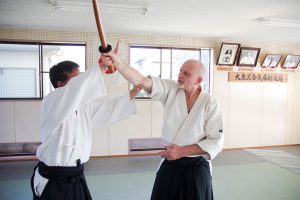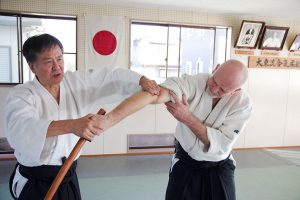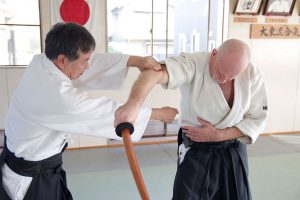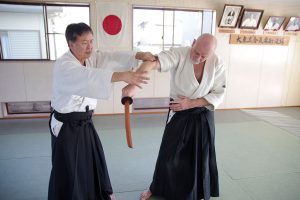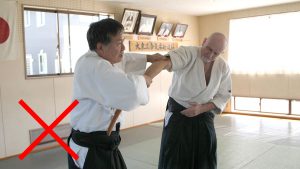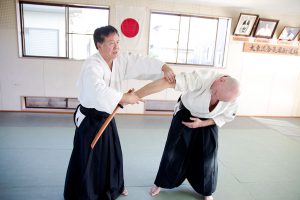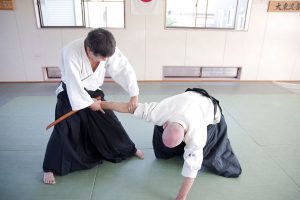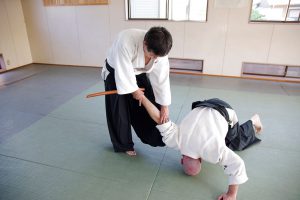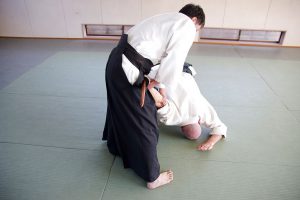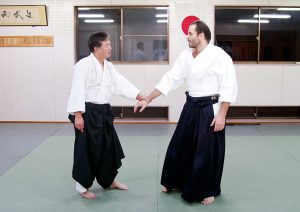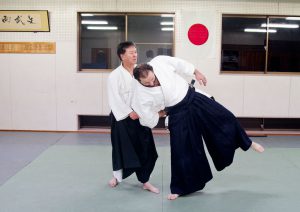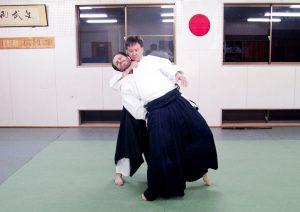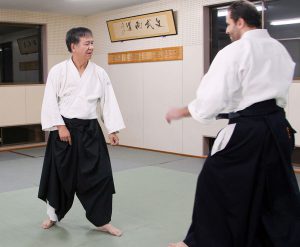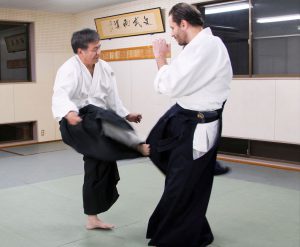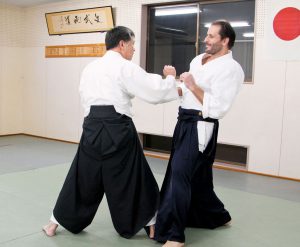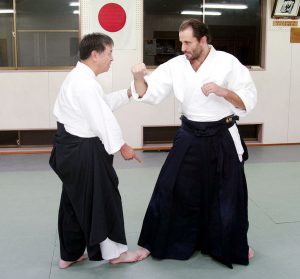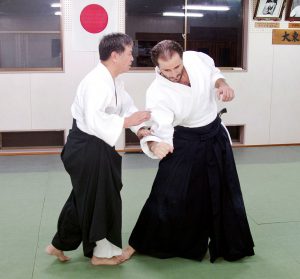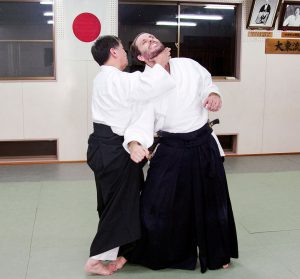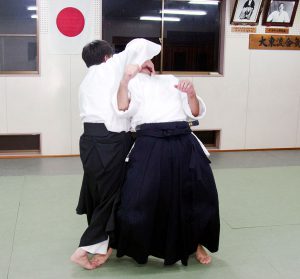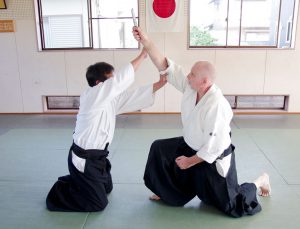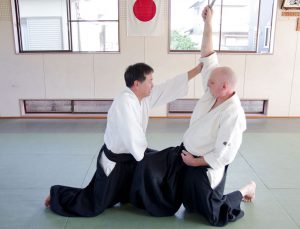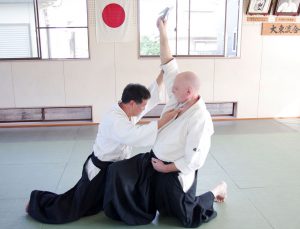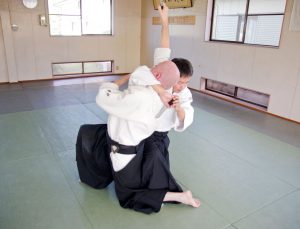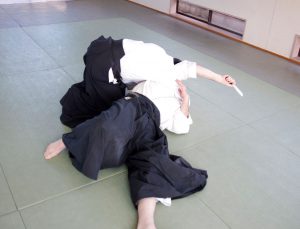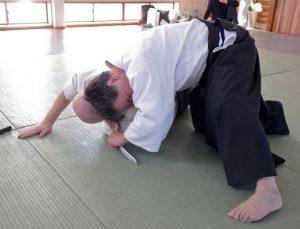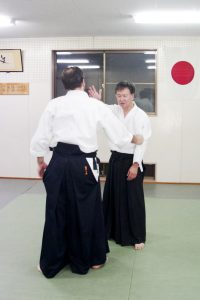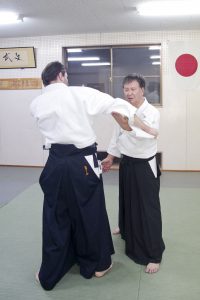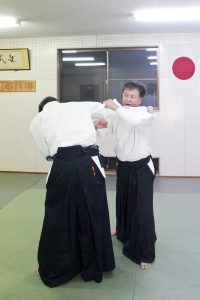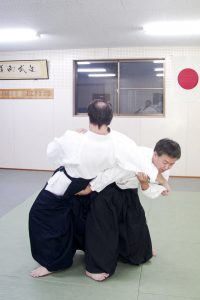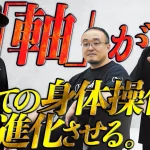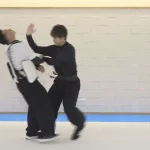Eagle Grab and Staggered Legs, Control Bones and Muscles And Win With Your Feet! [Daito-ryu of Shikoku #3]
Hideaki Sato, General Manager talks!
History and Techniques of Shikoku Daito-ryu Aiki-jujutsu
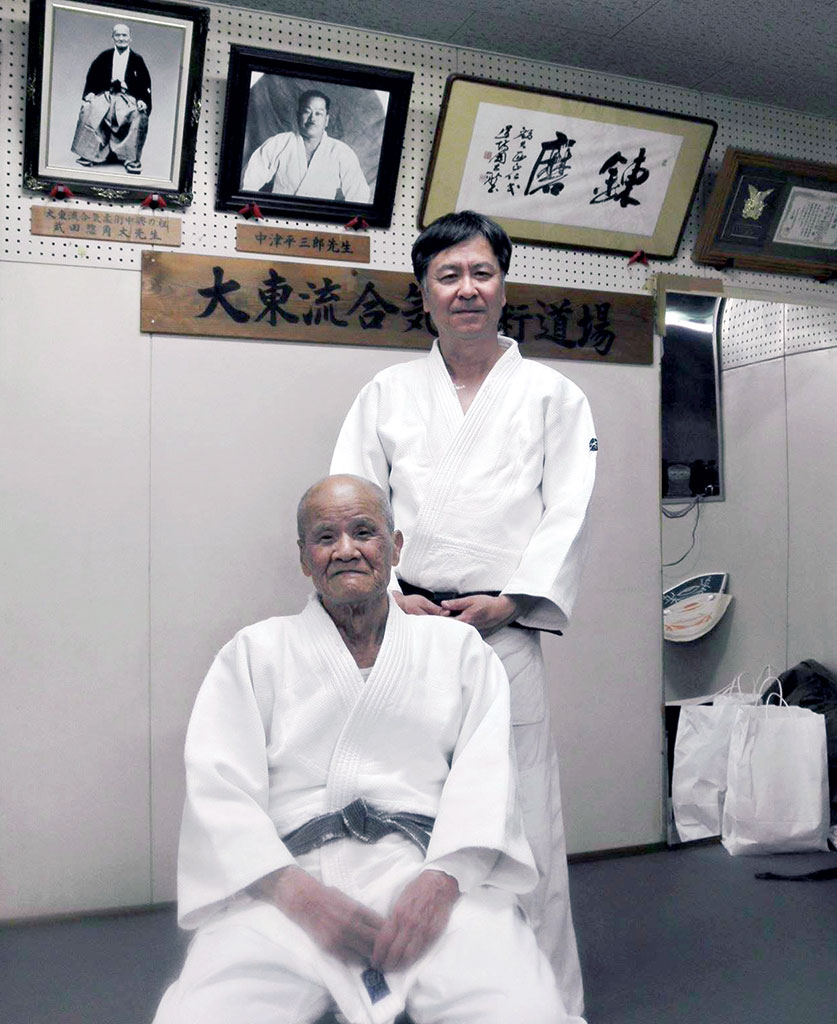
Chiba Shihan and Sato Shihan at the Daito-ryu Aiki-jujutsu Shikoku Headquarters Dojo.
Hideaki Sato is the successor of Nakatsu Heizaburo Sensei and Chiba Tsugutaka Sensei as the head of the Daito-ryu aiki-jujutsu Shikoku Headquarters. We visited the headquarters dojo in Wakimachi, Mima City, Tokushima Prefecture, and asked Sato Shihan about the characteristics of Daito-ryu Aiki-jujutsu in Shikoku.
A dojo where you can study Daito-ryu and refine your academic skills
Mima City, located in the northwestern part of Tokushima Prefecture, is a land rich in nature where the clear streams of the Yoshino and Anabuki rivers flow. There, one can visit the famous “Udatsu Townscape” in Wakimachi, which is a group of historical buildings that tell about the wealth and success of merchants of old. Onishi Masahito, who learned from Nakatsu Heizaburo along with Chiba Tsugutaka Shihan, retired from the health center where he was working and setup a place where he could study Daito-ryu and foster academic and martial excellence for youth development. The Daito-ryu Aiki-jujutsu Shikoku Headquarter Dojo was born.
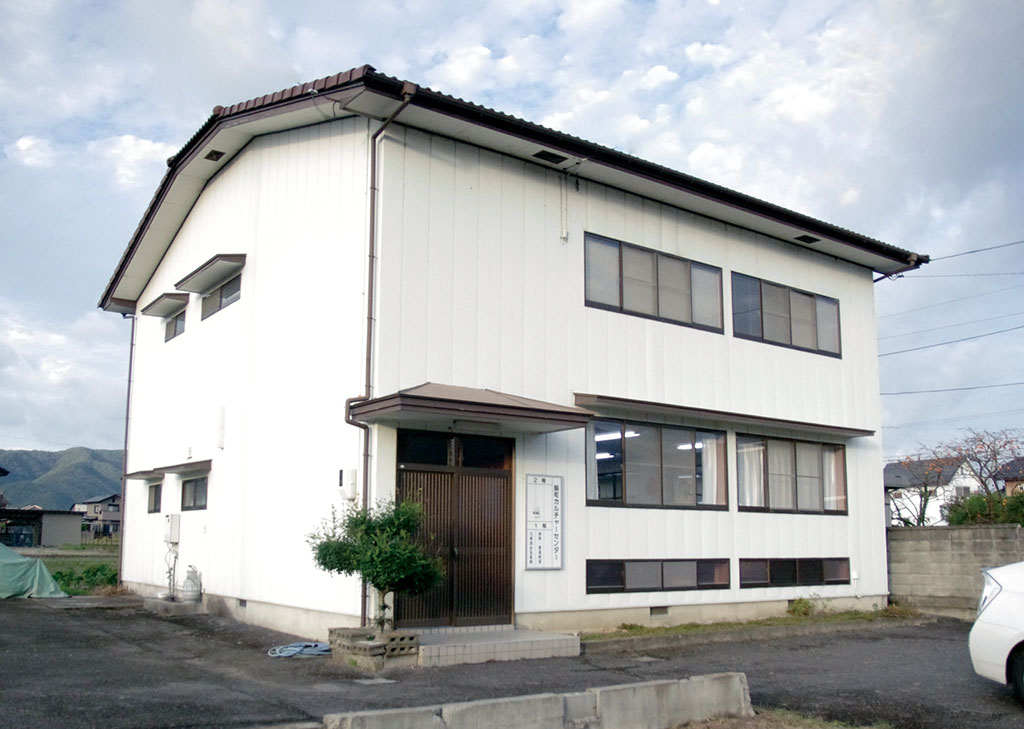
Daito-ryu Aiki-jujutsu Shikoku Headquarters Dojo in Wakimachi, Mima City, Tokushima Prefecture.
We visited the Shikoku Dojo in October 2020. We met with Guillaume Erard, — our guide for this special feature and a disciple of the Shikoku Dojo, — at Haneda Airport in the morning. After a short flight, we landed at Tokushima Awaodori Airport before noon and were greeted by Mr. Onishi Katsuhisa, the son of Onishi Masahito. While on the one-hour drive from the airport to the Daito-ryu Aiki-jujutsu Shikoku Headquarters Dojo, he made sure that we stopped to enjoy some famous local seafood dishes, and visit the first the Ryozenji Temple, which is the first of the 88 temples circuit in Shikoku that many pilgrims visit each year.
The Shikoku Headquarters Dojo is a two-story building, the first floor is a dojo with about 30 tatami mats, and the second floor is a place that can be used as a cultural center for academic activities such as writing and mathematics classes. At this dojo, we were able to meet Sato Hideaki, the successor of Chiba Shihan and his disciples. During that time, we got the chance to talk to Sato Shihan about the techniques of Shikoku’s Daito-ryu Aiki-jujutsu and the characteristics of the training system.
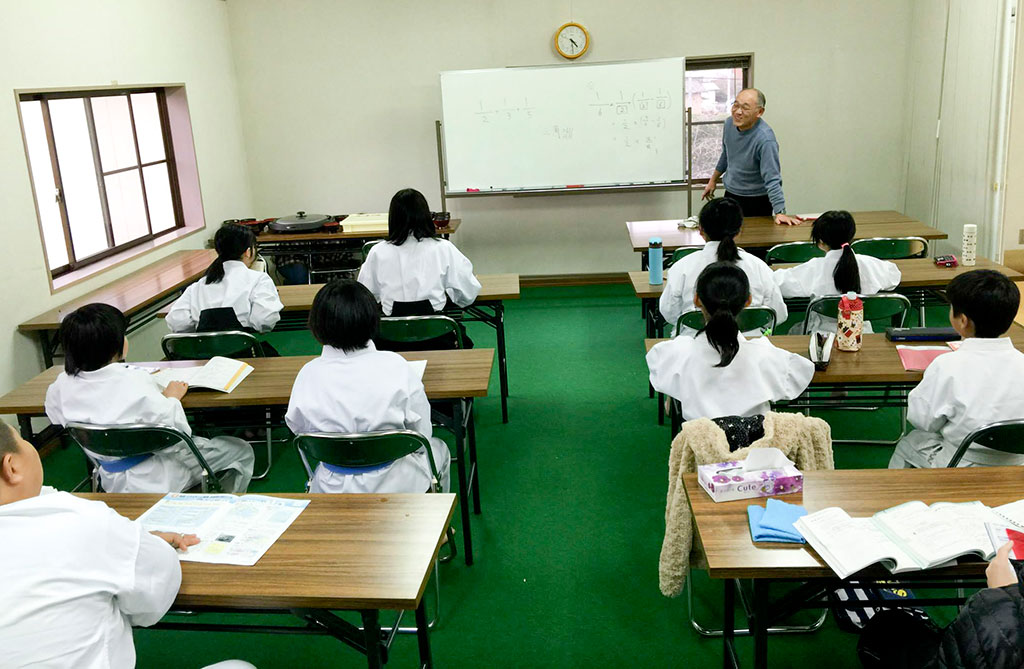
Wakimachi Culture Center Director Onishi Katsuhisa teaching mathematics on the second floor of the dojo.
How to take control of the elbow through the eagle claw
Sato Shihan met Chiba Shihan in 1989 when Onishi Shihan opened the Wakimachi Dojo (currently Shikoku Headquarters Dojo).
There were Chiba Sensei, Makita Kan’ichi Sensei, Izawa Masamitsu Sensei, and Onishi Sensei. Then, Chiba Sensei said, “Sato kun, come on!“, and since I was only 30 years old, I figured “if he says so, let’s go for it“, at that point, I think he did kotegaeshi. Rather than flying, I fell right on the spot, in a blink of an eye. I was dropped at his feet. It hurt so much that I cried. Then, Chiba Sensei asked me, “Would you like to try to learn our Daito-ryu?” Since that point, Chiba Sensei travelled from Ikeda to Wakimachi, and him and Director Onishi taught us the basic techniques using traditional training methods, as well as the 118 techniques curriculum [Editor’s note: this is a reference to the 118 hiden mokuroku technique that were organized into 5 kajo by Takeda Tokimune Sensei]. Chiba Sensei actually packed all of the techniques that he was taught by Nakatsu Heizaburo Sensei into the set of 118 techniques that he had later learned from Tokimune Sensei in Hokkaido and brought back to Tokushima. In addition to that, some techniques such as rotations and reverse arm grabs had already been transmitted to Shikoku.
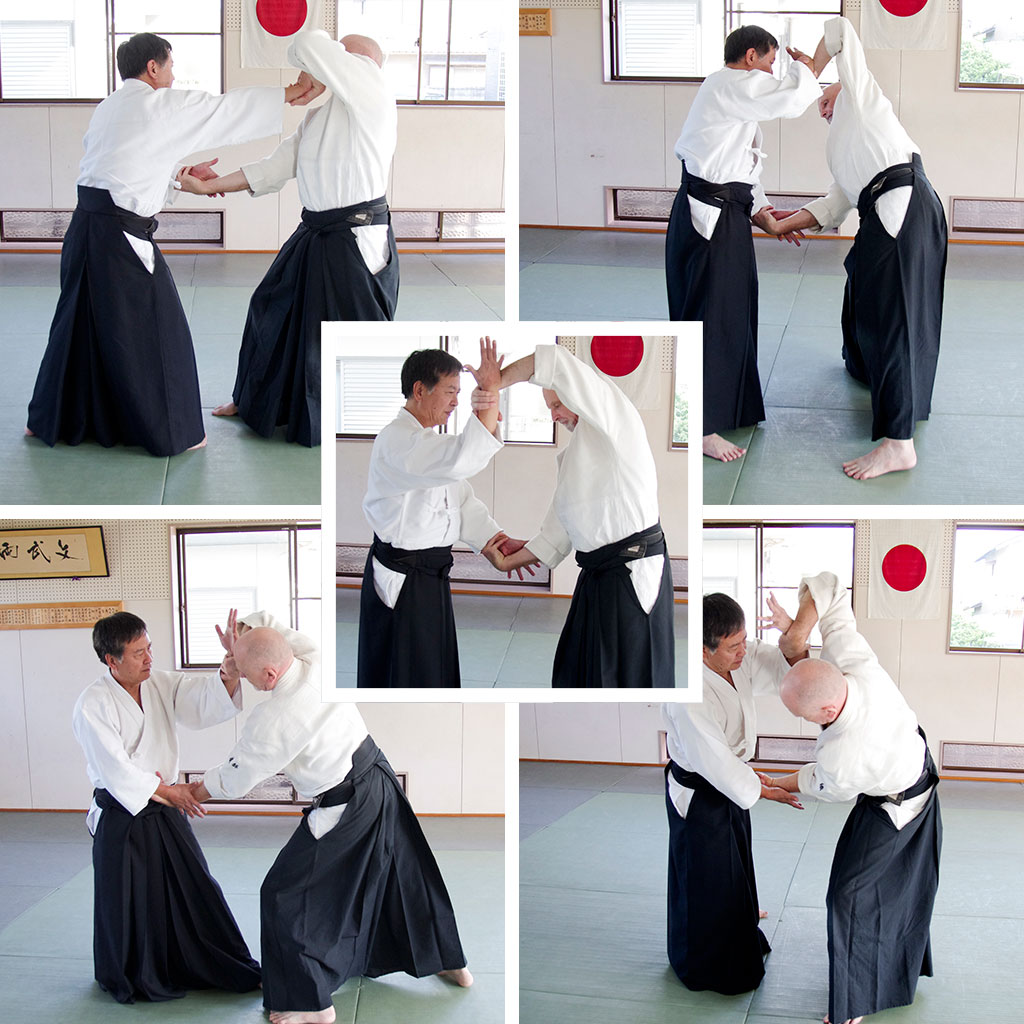
Kakete: Basic practice where when the wrist, sleeves, or collar are grabbed, one moves half a step back, forth, left, and right to destroy the opponent’s balance.
Sato Shihan was familiar with sports such as judo, kendo, and gymnastics when he was a student, but he said that it was the first time that he came into contact with kobudo. At first, he thought that Daito-ryu was unified nationwide and he assumed that it was the same everywhere, but 14 or 15 years after, it became clear to him that the interpretations and methods behind the techniques differed cnsiderably depending on each school, group, and even instructor. He said that:
I think that Shikoku’s technique have remained very close to what they were in the past. Chiba Sensei and Director Onishi taught me the following from the beginning: “Do not let the opponent go more than one tatami mat away from you.” This is why we perform the techniques in a such a way that we move in half a steps. There is no need to throw the opponent away, instead we bring him to our tanden, center line, to deprive him from his points of contact with the floor. For that purpose, it is important to control the wrists, the elbow joint, and the thumb. We always practice with an emphasis on not using grabs to control the opponent, or not let the opponent manipulate our elbows or thumbs.
Also, one of the characteristics of the Daito-ryu in Shikoku resides in the manipulation and the control of bones and joints through the use of pressure points, which has been emphasized as an oral tradition. This is largely due to the fact that Nakatsu Heizaburo, who was a judo rehabilitation teacher, was able to recognize the deep effects of Takeda Sokaku’s technique on the human body and explain them to his disciples.

Eagle claw: ❶ In order to control the elbow, dig up the opponent’s muscles and flesh starting from the thumb in a manner similar to an eagle catching its prey, and then start to put the index finger near the radial head. ❷ Next, apply pressure to the elbow joint / muscle in the order of the middle finger, ring finger, and little finger. In the basic movement, you don’t align your fingers in a straight line, but break them apart and make sure that one of the four fingers grabs the pressure point. ❸ Once you have applied the eagle grab, operate an ulnar deviation, as if to establish contact towards his elbow bone to stop the opponent’s elbow.
The important thing if one wants to control bones and joints is to know how to “hang” and “grip” the hand. From the beginning, the Shikoku Headquarters teach in detail what part should be captured and how by using the “eagle claw”. Sato explained that Chiba Shihan and Onishi Shihan often used to do suburi using a thick wooden utility pole of about 180 cm as their basic tanren method. Here, the important point is to “grab” something that cannot be held easily with one hand, lift it up, swing it down, and squeeze it in front of one’s tanden. They also practiced using a bamboo stick with the base of the stick away from them, holding the thin tip in one hand, but instead of grabbing it, “pinching” it as if they were doing yonkajo, then turning their wrist back to lift the base. They practiced this exercise by alternating left and right hands. Sato says that due to this tanren, the forearms of Chiba Shihan and Onishi Shihan became as thick as the thighs of their legs, but even so, he said that they taught him to focus on training the wrists, rather than the muscles. These old-fashioned methods are training methods that have been handed down since the days of Nakatsu Heizaburo.
When Nakatsu Sensei told Takeda Sokaku Sensei that he practiced judo as a police officer, Sokaku said: “Judo itself is not a real self-defense, so you should do Daito-ryu style judo instead.” Using what we know today as the 118 basic techniques, additional material was taught such as controlling the elbows and joints using the dogi, how to counter when the chest is held (mune dori), how to unbalance the opponent with chidori, etc. Nakatsu Sensei learned such things from Sokaku Sensei, and they have been passed on to us through Chiba Sensei and Onishi Sensei.
The importance of advanced footwork
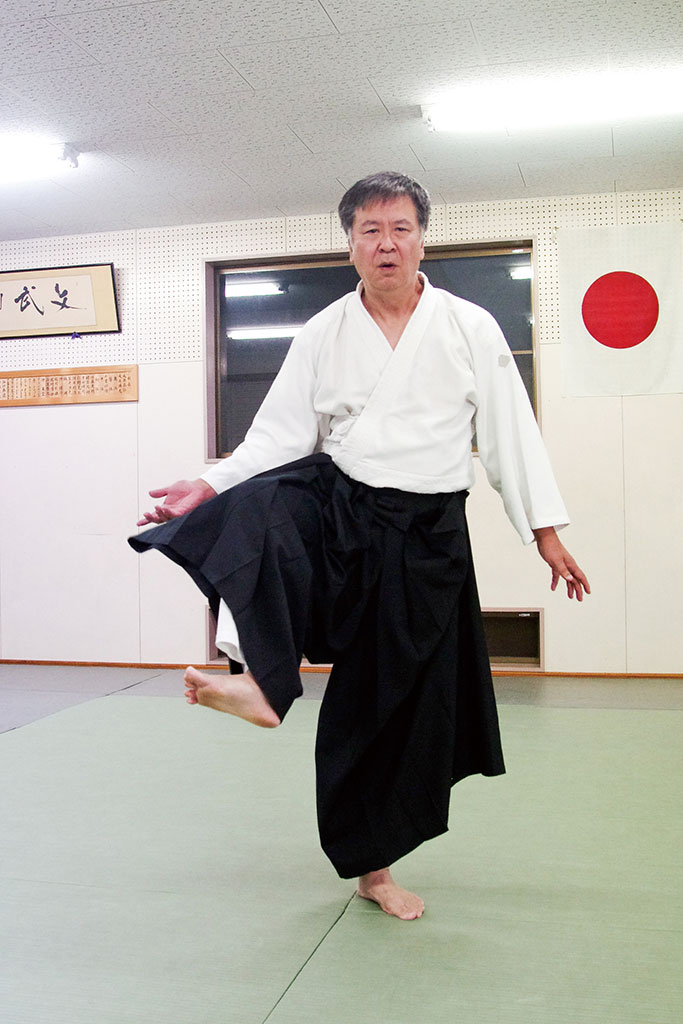
Chidori ashi: The walk of the plover bird
When training in Shikoku Daito-ryu aiki-jujutsu, one starts by learning idori techniques (capture techniques while seating). It is therefore a type of situation where the distance between the opponents is fixed. The second phase of learning is called hanmi handachi. Those techniques are performed while sitting against an opponent who is standing, and therefore one learns how to break the balance of an opponent in spite of a height difference of 1.5 to 2 times. Here, one masters how to deal with opponents coming at oneself from all directions, and how to drop them towards one’s center. It is only once one can do all this that one can practice in tachiai (standing techniques). In tachiai, one is able to move freely in terms of both the distance and the direction. Regardless of who they are, as soon as someone who attacks, they immediately define themselves as an enemy. When the opponent’s arm or foot hits, it is close to that distance, so one learns to control it through the joints, elbows, and feet. The last thing that one learns is ushiro dori.
According to Chiba Sensei, the meaning of ushiro dori is to turn the body on the soles of the foot using chidori ashi [Editor’s note: a way of moving that mimics the mode of locomotion of the plover bird, i.e. zig zag], to overcome and stop the enemies on all sides. When a technique is practiced using chidori ashi, they take fewer steps and become faster and more powerful. It seems however that such footwork is no longer used very much nowadays.
Many of the major lessons in Daito-ryu focus on grabbing techniques. In spite of this particular emphasis on grabs, Sato Shihan says that if one doesn’t learn how to control one’s body, legs, knees, and feet, one will always be behind by one or two moves, which will not be conductive of advanced progress.
While Chiba Sensei and Onishi Sensei taught me using the basic 118 techniques, they did so by adding information such as: “If you do this, it will become a soden technique.” or “If you change this like this, it will be an okuden technique, or like that, then it will become a kaiden technique.” I learned such things from the training sessions and during seminars. Now whenever I look back at the scrolls, the meaning of content written there often changes depending on how I interpret it. For instance, it could be a transformation of a particular technique of nikajo, and the only difference is the point of attack. This leads me to think that if you look at a technique simply in terms of chidori or ushirodori and eliminate unnecessary things, it can quickly take new dimensions, that are close to those of the soden.
The seeds of aiki are hidden in the basic techniques
Since he entered the Wakimachi Dojo 32 years ago, Sato Sensei was told things such as “This technique takes 10 years, this one takes 20 years”, and after learning from his masters for a long time, he eventually came to understand how to apply aiki.
Chiba Sensei and Onishi Sensei used to say that “One’s humanity is put into question from the point one becomes yondan or higher.” One’s human nature is revealed through a tanren of the heart, and the way one interacts and speaks with people becomes more important as one goes up in seniority. Hearing such stories, I also studied various things in other martial arts. At one point, I happened to understand what Shioda Gozo was doing when I saw him perform a hip control technique. I thought, “isn’t everything different when applied with aiki?” so I hurriedly went to Chiba Sensei’s home to tell him. When I asked Chiba Sensei, “Is this how you apply aiki?“, he replied “Sato, so you did understand that? Well, once you know that, the next step is to use the ‘rock’[Editor’s note: as in the fist in the rock, paper, scissor game]” This was indeed what he had taught me.

The Daito-ryu gold badge above was given by Chiba Shihan to Sato Sensei when he received his approval. According to Chiba Shihan, the Daito-ryu aiki-budo Shikoku Headquarters produced badges for made of copper, silver, and gold and awarded along with the hatsuden, chuden, and okuden licenses, respectively. At that time, there was also a branch in Kochi.
Sato Shihan says that if one is able control the opponent’s elbow with the eagle grab, one will be able to control them using tegatana (i.e. even without needing to grab). By knowing human physiology from controlling bones and muscles, Sato Shihan demonstrated to me that it is possible to control the opponent in the same way with a closed fist and without any effort.
If one only looks at the master’s technique as he breaks the balance of his opponent, one can never see the process of why it happened. The depth and awesomeness of Daito-ryu as a kobujutsu may precisely reside in its training process. Sato Sensei said the following with confidence:
The seeds of aiki are found here and there through the process of learning the basics of kuzushi from ikkajo to the rest of the 118 techniques. Aiki is something that takes into account your efforts and humanity. There are many possibilities and opportunities to understand this at the Shikoku Headquarters Dojo.
Many schools include these fundamentals of budo and bujutsu in their basic curriculum.
At the Shikoku Headquarters Dojo, we study ippondori, gyaku ude dori, hiji gaeshi and kuruma daoshi in order, but I initially wondered why hiji gaeshi was in the third place. At first, I thought that hiji gaeshi was just for practicing ukemi, but after watching the teachers’ techniques and kuzushi for a long time, I realized that hiji gaeshi was meant to practice sankajo‘s kuzushi. Everyone at the dojo knew that. Ippondori follows the principles of ikkajo, and gyaku ude dori follows the principles of nikajo. In hiji gaeshi, the shape of the hand when you bring it to your chest and lock the elbow is done according to the principles of sankajo, and likewise for kuruma daoshi and yonkajo. I understood that the practice of from ikkajo to yonkajo mirrors the first to fourth techniques of the 118 kajo. The process gradually continues through the study of the 118 techniques. It gets easier and requires less work, but in the end it’s all connected.
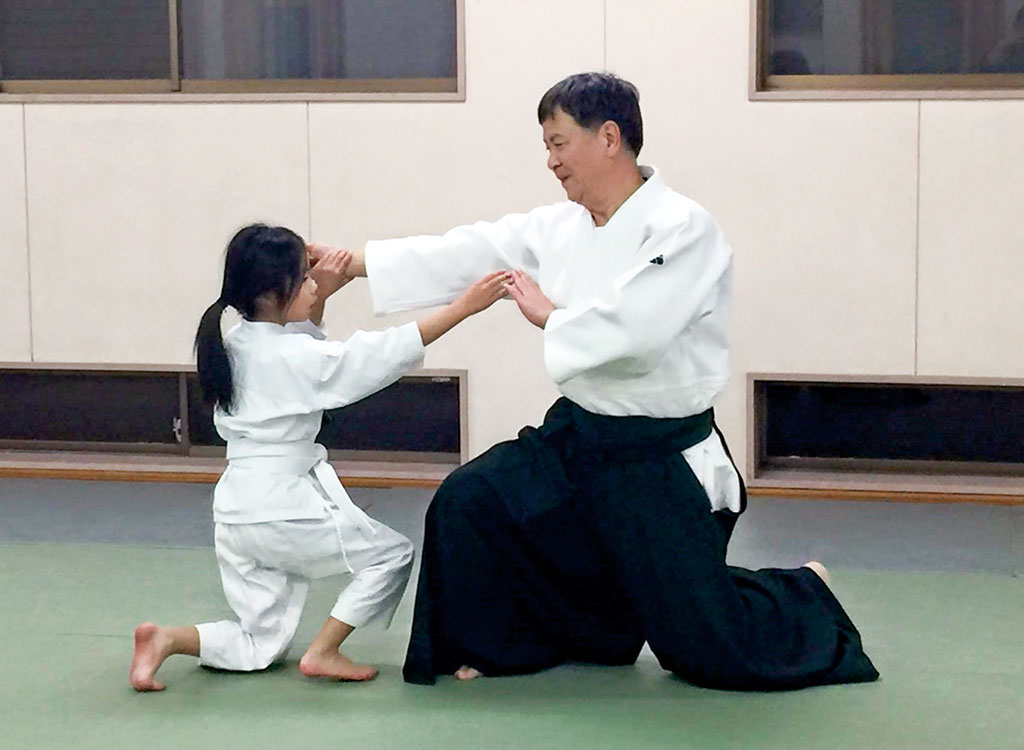
Another feature of this dojo is that children and adults are practicing the same content of Daito-ryu Aiki-jujutsu.
Currently, Sato Shihan is devising ways to number each of “ikkajo, nikajo, sankajo, yonkajo, gokajo” as “1, 2, 3, 4, 5”. For example, even while doing an ikkajo technique, whether it is to children or adults, he combines those numbers and the discrete points inside the technique in a way such as “Here, it is similar to 2, here it feels like 3, hold it and control the elbow with the eagle claw like in 4!”
Once you understand the technique, you can understand the amazing way in which the 118 techniques kata was created by Takeda Tokimune Sensei and the order in which the techniques were put together. I think that if you can see the form of the technique in that way through numbering, you will deepen your understanding. This way of doing doesn’t suit the times, but I encourage anyone to study this as much as possible.
“Takeda Tokimune’s recollection of intense training at the Osaka Asahi Newspaper”
The following is the translation of an excerpt from the “Daito-ryu Aiki-budo” newsletter, Issue No. 5 – January 1, 1975, that features an account of the Shikoku practitioners.
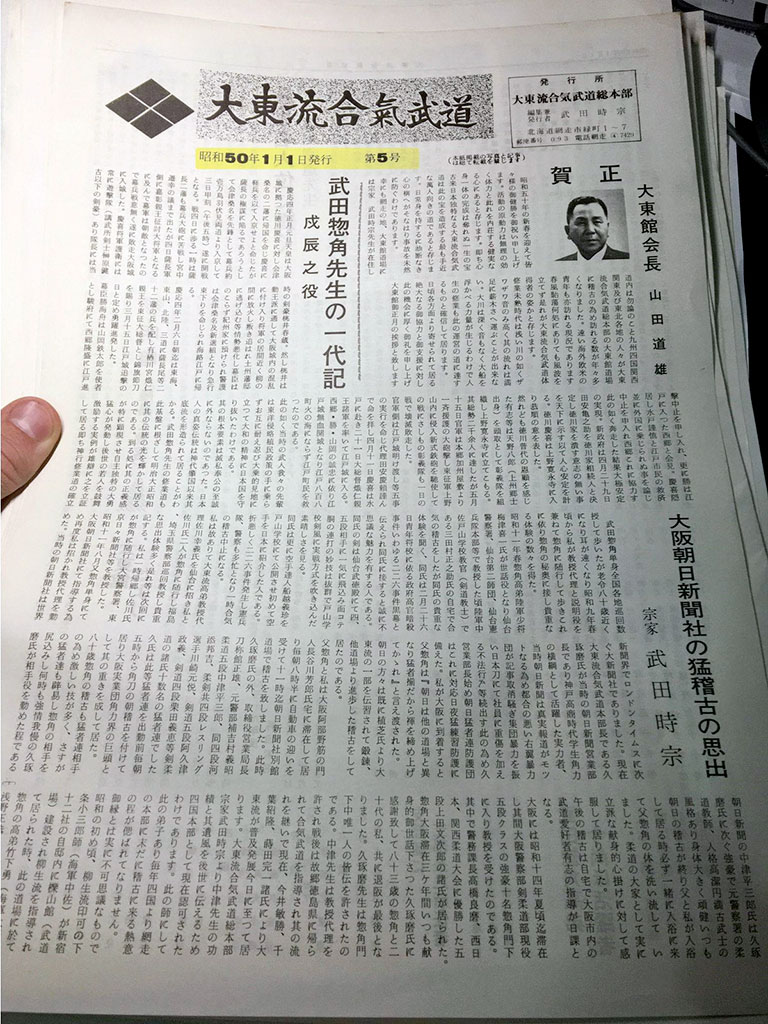
“Daito-ryu Aiki-budo”, Issue No. 5 – January 1, 1975. [kindly provided by Mr Marc Trudel on behalf of Mr Kondo Katsuyuki of Daito-ryu aiki-jujutsu Mainline.]
[…]In august 1936, I was asked to join Sokaku in Osaka and assist him with the teaching at the Asahi Newspaper. When I arrived in Osaka, my father told me: “Unlike other dojos, Asahi is full of fierce men, so you’d better be ready for it.” The Asahi group had already learned a part of the Daito-ryu system from Mr. Ueshiba, so they were more advanced than in other dojo. My father Sokaku and I stayed at the house of one of the students, Mr. Hasegawa Yoshiro, in the Abe Nosuji district of Osaka. We would be picked up by car at 8:30 every morning and practiced at the Asahi Shimbun Annex Dojo until 11 o’clock.
In addition to Mr Hisa Takuma, students at that time included a dozen or so fierce men such as the Director of the Sales Bureau, Mr Tonedate Masao; a Former Assistant in the Police Department, Mr Yoshimura Yoshiteru; judo 5th dan Nakatsu Heizaburo and 4th dan Kawazoe Kuniyoshi; juken and wrestling 4th dan Kawasaki Zenetsu; and kendo 5th dan Akune Masayoshi and 4th dan Kurita Yoshie.
[…]The eighty-year-old Sokaku had to adapt his practice and he included a lot of severe techniques to match those strong opponents. As a result, even those fierce men were intimidated, and and it is Mr. Hisa Takuma who would often serve as his opponent. Mr. Nakatsu Heizaburo was the second strongest man after Mr. Hisa Takuma at the newspaper. He was a former judo teacher in the police and had the noble and wise personality of a samurai. For instance, he used to take my father to the bathhouse and wash his body. I was impressed by the dedication of this judo master.
[…]I am grateful to him and to Mr. Hisa Takuma for their dedication during the three years of our various stays in Osaka. When we left Osaka for the last time, Sokaku was 83 years old and was in my twenties. Hisa Takuma was awarded the only kaiden by Sokaku. Nakatsu Sensei was awarded the kyoju dairi, and after the war, he returned to his hometown in the Tokushima Prefecture and taught aiki-budo to people including Imai Toshikatsu, Chiba Tsugutaka, and Makita Kan’ichi, who subsequently popularized and developed Daito-ryu. The Daito-ryu Aiki-budo Headquarters Soke, Takeda Tokimune, has now approved the Shikoku Headquarters to pass on the achievements and legacy of Nakatsu Heizaburo to posterity. The teachers and disciples of the Abashiri Headquarters still remember to this day the enthusiasm of the Shikoku members as they came every year to practice.
Technical explanations
Basic Technique: Ikkajo Shomen Uchi Ippondori’s Eagle Claw
- ❶ Receive the opponent’s frontal strike with both hands. The right hand receives the wrist by the action of sweeping the opponent’s sword, and at the same time, immobilize the opponent’s elbow joint by grabbing the pressure point of the elbow with the left hand.
- ❶’ If you don’t grab properly, the opponent will be able to use his elbow to cut your neck.
- ❷ Rotate the elbow to control the right wrist and use it as a lever.
- ❸ Strike in the pressure points of the ribs or the spleen.
- ❹ Immediately control the opponent’s wrist with the right hand, so put the little finger and ring finger in that order. At this time, do not grab or grab and pull.
- ❹’ If you grab the wrist too early and pull toward yourself, the opponent will cut your abdomen.
- ❺ Take a yonkajo hold to immobilize the opponent’s wrist joint.
- ❻ With the opponent’s elbows and wrists under control, move your right foot one step (short or long, according to the opponent’s height and arm length) as if you were sweeping the floor, and make sure the opponent is unbalanced to the point that he puts his left hand on the ground. Your hips and your opponent’s body must be parallel.
- ❼ Next, move toward the opponent by kicking his side with your left foot.
- ❽ While keeping control over the extended elbow, lean forward as if piercing with a spear in the ground to fix the opponent.
- ❾ Open your right foot in a fan shape and then point your right big toe toward the opponent’s head. You may open and close as many times as you like, depending on the length of the opponent’s arm.
- ❿ When you take the sword, rotate your wrist outwards, keep your right hand in the yonkajo position, until you let go of his hand.
- ⓫ Exit towards the head of the opponent.
Basic Technique: Katatedori Waki Zume
- ❶ When the opponent tries to grab you left wrist, take the initiative and grab the opponent’s incoming right wrist with your left hand and apply the yonkajo point.
- ❷ At the same time as raising the opponent’s hand, rotate 360 degrees without any additional step, using the sole of the foot while holding your knee up. Pass your shoulders, waist, and left foot together quickly (*This way to move is the same as the one on ikkajo on the above pictures. It enables you to attack and defend with the power of rotation).
- ❸ Apply the sankajo grab as you move.
- ❹ From behind, use the sankajo grab to guide the opponent in front of you.
- ❺ Grab the opponent’s front collar and operate a carotid restraint.
Application: Chidori vs. low kick
- ❶ The ideal stance is that of a Nio statue. However, the left guard assumed here is inviting the opponent to strike your left leg.
- ❷ Since your weight is on your left foot, you can intercept the opponent’s kicking foot with your right foot. Be sure to use the soles of your feet and land on his knee, which have less momentum than his foot.
- ❸ Transfer your weight to your right foot as you put it down and use the power of that momentum to give an atemi with your fist. 受け手の拳を自らの急所以外に受けるのは良しとし、決して引き下がらずに前に進み制する。
Application: Chidori vs. punch
- ❶ As soon as the opponent steps in, move forward in a straight posture, kick the opponent’s legs at the level of the kneecaps, and handle the opponent’s fist.
- ❷ Place the big toe on the other person’s foot and stomp it so that it pierces, while shifting the center line of the opponent.
- ❸ Drop the opponent’s elbow toward your center of gravity and unbalance him forward.
- ❹ Use your right hand to move to the opponent’s throat using the opponent’s upward reflex action. It is indispensable to approach and move as if brushing his chest so that the opponent not realize the movement.
- ❺ Raise your elbows to tilt your opponent’s chin.
- ❻ Shift your body weight forward and drop the opponent straight down.
Gyaku Dasuki
An example of technique taught by Chiba Shihan and Onishi Shihan: “Do like the name of the technique says“.
- ❶ Grab the elbow to prevent the opponent from coming forward with a dagger.
- ❷ While stepping on the outside of the opponent, turn the back of the elbow that you grabbed using the eagle claw to bring it toward the opponent’s ear, take the knife at your waist with your right hand.
- ❸ Put your left knee on the ground. While sinking, slide the knife against the opponent’s left carotid artery.
- ❹ Bring your right foot forward, align your right arm against the opponent’s back, which will tilt your opponent’s chin backwards, and hold your dagger with both hands to pierce his back.
- ❺ Place the opponent on the ground as it is,
- ❻ Stretch your left foot and raise his head so that his right shoulder stands vertically, and push his shoulder forward it while squeezing his neck.
Ura Otoshi
This is one of the techniques that makes used of the dogi, as transmitted by Nakatsu Heizaburo.
- ❶ When you left sleeve is being grabbed, strike the opponent’s head with your right hand.
- ❷ Place your left hand on the opponent’s arm from below so that the his dogi ends up wrapped around the back of his elbow.
- ❸ Raise your left hand as it is, bring your palm above the opponent’s elbow, and bundle them together so as to eliminate the play of the dogi, so that the opponent’s elbow is held tightly. While putting the atemi on the flank with the right elbow,
- ❹ take a half step with your right foot to go towards the opponent’s back and strike his back with your elbow.
- ❺ Throw him down as if hitting the opponent’s lower back.
- ❻ Keep you hold on the elbow until the end, and stomp with a kick. This technique cannot be overturned by just momentum. You can drop it in any direction by both maximizing the opponent’s elbow and striking your own elbow.
Sato Hideaki Shihan Profile
Sato Hideaki was born in September 1958 in Utsunomiya, Tochigi Prefecture and he grew up in Toyonaka, Osaka. After graduating from a high school attached to the Osaka Institute of Technology, he entered a computer vocational school. He then moved to his father’s hometown of Mima City, Tokushima Prefecture, and took over his business. Through his activities as the Deputy Branch Manager of the Chamber of Commerce, Mima District Probation Officer, and the Children’s and Civil Affairs Committee, he became acquainted with Mr. Onishi Masahito, then member of the City Council. When Onishi opened the Wakimachi Dojo in 1989 with the aim of promoting the teaching of budo and culture, Sato joined and was able to train in Daito-ryu aiki-jujutsu under Onishi, Chiba Tsugutaka, Makita Kan’ichi, and Izawa Masamitsu. After the death of Onishi and Chiba, he inherited the Shikoku headquarters from July 2019 and continues to the present day.
Interview / text ◎ Editorial department of Gekkan Hiden magazine. We would like to express our sincere gratitude to all the members of the Shikoku Headquarters.

